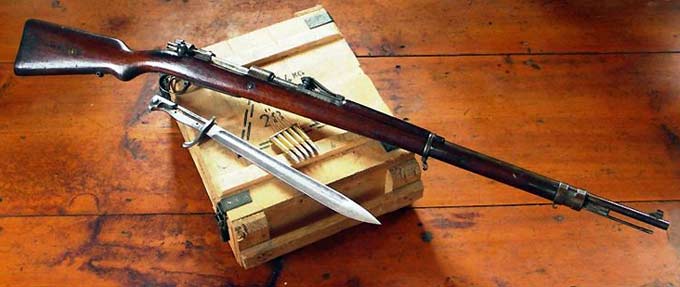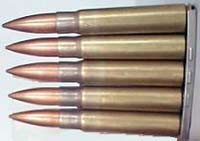
Eventually in 1898 the German army also purchased a Mauser design, the Model 98. M98 incorporated improvements of earlier models, and entered German service as the Gew. 98 officially on April 5, 1898. This remains by far the most successful of the Mauser designs, helped of course by the onset of two World Wars that demanded vast numbers of rifles.
.jpg) Noticeable changes from previous Mauser rifle models included better ruptured case gas venting, better receiver metallurgy and larger receiver ring dimensions for handling the pressures of the 7.92x57 cartridge. Mauser also incorporated a new, third "safety" lug on the bolt body to protect the shooter in the event that one or more of the forward locking lugs failed. In 1905 the "spitzer" round was introduced, in response to the French adoption of a pointed round, which offered better ballistic performance. The bullet diameter was increased from 0.318" to 0.323". This improved round also copied the pointed tip design instead of the previous rounded nose profile, and most existing Model 98's and some Model 88's were rechambered for the round, designated "7.92 x 57IS". Pointed rounds gave the bullet a better ballistic coefficient, improving the effective range of the cartridge by decreasing aerodynamic drag.
Noticeable changes from previous Mauser rifle models included better ruptured case gas venting, better receiver metallurgy and larger receiver ring dimensions for handling the pressures of the 7.92x57 cartridge. Mauser also incorporated a new, third "safety" lug on the bolt body to protect the shooter in the event that one or more of the forward locking lugs failed. In 1905 the "spitzer" round was introduced, in response to the French adoption of a pointed round, which offered better ballistic performance. The bullet diameter was increased from 0.318" to 0.323". This improved round also copied the pointed tip design instead of the previous rounded nose profile, and most existing Model 98's and some Model 88's were rechambered for the round, designated "7.92 x 57IS". Pointed rounds gave the bullet a better ballistic coefficient, improving the effective range of the cartridge by decreasing aerodynamic drag.
Paul Mauser died May 29, 1914 before the start of World War I that August. World War I would see very large spike in demand for the company's rifles, as well as a number of variants of it. This included the several 98 carbines as well as an experimental version with a twenty round, rather than five round, box magazine. The extended magazine was not well received, however.
A number of carbine versions known as Karabiner 98's had been introduced and used in World War I, some of which were even shorter than the later K.98k. These carbines were originally only distributed to cavalry troops but later in the war to the special stormtroop units as well.
 The Mauser company, established by the two Mauser brothers, established its reputation in firearms making in the last decades of the XIX century, and continued to build a very well thought-out and skillfully built firearms until the end of the World War 2. Some years after the WW2, the Mauser company was restored in the West Germany and continued to build firearms, but mostly a larger-caliber ones, like the aircraft cannons etc. But some of earlier Mauser works became the standards against which all others designs are judged, even after some 100 years after its introduction. One of such designs, is undoubtfully a Mauser model 1898 rifle, also known as Gew. 98 or simply G98 (G = Gewehr, rifle in German). This rifle was designed from the experience, gained on previous Mauser designs, and was first appeared in 1898 as a standard German army infantry rifle. It was carried by Germans through the First World war, along with carbine shortened version, known as K98 (or Kar-98, from Karbiner = carbine). In the 1904 Germans were first to introduce the new, "spitzer" bullet (with pointed tip, instead of the older blunt, round-shaped tip). New bullet had much better long-range ballistic, so all sights were regraduated for new ammunition.
The Mauser company, established by the two Mauser brothers, established its reputation in firearms making in the last decades of the XIX century, and continued to build a very well thought-out and skillfully built firearms until the end of the World War 2. Some years after the WW2, the Mauser company was restored in the West Germany and continued to build firearms, but mostly a larger-caliber ones, like the aircraft cannons etc. But some of earlier Mauser works became the standards against which all others designs are judged, even after some 100 years after its introduction. One of such designs, is undoubtfully a Mauser model 1898 rifle, also known as Gew. 98 or simply G98 (G = Gewehr, rifle in German). This rifle was designed from the experience, gained on previous Mauser designs, and was first appeared in 1898 as a standard German army infantry rifle. It was carried by Germans through the First World war, along with carbine shortened version, known as K98 (or Kar-98, from Karbiner = carbine). In the 1904 Germans were first to introduce the new, "spitzer" bullet (with pointed tip, instead of the older blunt, round-shaped tip). New bullet had much better long-range ballistic, so all sights were regraduated for new ammunition.
During the interwar period this fine design was slightly altered to became the K98k - Karbiner Kurz, or short carbine - a somewhat shorter, lighter and handier version of the original one. This version appeared in 1935 and was manufactured until the 1945 in large numbers not only by Germans, but also in numerous countries, occupied by Germans. Many versions of this design also were licensed to other countries, which also used to build their own versions of the G98. Most famous of those "foreign Mausers" are Persian Mausers, Turkish Mausers, Czech VZ-24 Mausers, Yugoslavian Mausers and some others. The list of the vast variety of the Mauser-type versions could easily cover a number of pages, but, for the sake of compactness, I will describe only the basic, German model.
The model 98 rifle is a manually operated, magazine fed, bolt action rifle. The magazine and the bolt action are the two most famous features of the model 98. Magazine is a two-row, integral box, with quickly detachable floorplate. Magazine could be topped either with single rounds, by pushing rounds into the receiver top opening, or via the stripper clips. Each clip can hold 5 rounds, enough to fill the magazine, and is inserted into the clip guides, machined into the rear receiver bridge. After the loading, empty clip is ejected automatically when bolt is closed. Magazine could be unloaded by operating the bolt (safety must be in the middle position!) or by removing the magazine floorplate (not recommended).
Mauser bolt is a simple, extremely strong and well thought out design. The bolt has three locking lugs, two at the bolt head and one at the rear part of the bolt. The bolt handle is rigidly attached to the bolt body. On the original Gew 98 rifles it was straight and located horizontally when bolt was in the closed position. On the K98k the bolt handle was bent down, which allowed for more comfortable carrying and bolt operations. Bolt has a gas vent holes that are designed to move the hot gases away from the shooters face and into the magazine opening in the case of the cartridge case or primer rupture. Next famous feature of the model 98 bolt is a "controlled feed" extractor. Massive, non-rotating claw extractor was designed to engage the cartridge rim as soon as cartridge left the magazine, and held the cartridge case firmly until it was ejected by the ejector, fixed inside the receiver. Combined with a slight bolt retraction at the last stage of the bolt turn-open rotation, caused by the cammed surface on the rear receiver bridge, this resulted in very positive primary extraction. Model 98 is a striker-fired weapon. Striker is cocked when bolt is rotated to open, allowing for smoother forward bolt pull. The rear part of the striker is protruded from within the bolt, so state of the action (cocked or not) can be checked visually or even manually. The bolt group can be easily removed from the receiver simply by pulling out the bolt stop, located at the left wall of the receiver, and then by rotating and pulling the bolt out. The safety switch is located at the rear of the bolt and has three positions: in the left position (when looking from behind the rifle) it locks the sear and also locks the bolt in place, so it could not be rotated and opened. in the middle (raised) position it still locks the sear, but bolt is unlocked and could be operated, to load and unload the rifle; and in the right position, the rifle is ready to fire. Safety could be easily operated by the right thumb finger.
Model 98 rifle featured a one-piece wooden stock with semi-pistol grip. Gew 98 and Kar 98K differ not only in the length of the barrel and the front part of the stock - they also have different sling mountings. While Gew 98 has two sling swivels, the K98k has only one, forward swivel. Instead of the rear swivel there's a through cut in the buttstock, through which the sling is passed. Those rifles also have different rear sights: Gew 98 have a curved, tangent sight, while K98k has more modern, leaf type rear sight. Front sights are of open, barleycorn type, on some carbines with removable semi-circular front sight hoods.
G98 derivatives
A great number of military rifles derived from the M98 design. Some of these were German-made by various contractors apart from Mauser, and include the M1899 Serbian in 7x57 mm, M1902 Mexican in 7x57 mm, M1903 Turkish in 7.65x53 mm, M1904 Portuguese 'Mauser-Vergueiro' 6.5x58mm, M1909 Argentinian in 7.65x53 mm, and numerous others.
Following the collapse of the German Empire in the WW1, many countries that were using Mauser models chose to develop, assemble or modify their own G98-action rifle designs; The most prolific were the Czechoslovakian M1922 CZ 98 and M1924 CZ vz.24 and the Belgian Fabrique Nationale M1924 and M1930, all in 7.92x57 mm.
The Belgians and Czechs produced and exported widely their 'Mausers' in various calibers throughout the 20s and 30s, before their production facilities were absorbed by the conquering Nazi Germany and used to produce parts or whole rifles for the German army. Strictly speaking these are not Mauser rifles, as they were not engineered or produced by the Germans. It is a common misconception that the Czech and Belgian 'Mausers' are copies of the K98k due to their superficial similarity in length, in reality these were developed at least 10 years earlier and as they were peace-time products, they are renowned for their high standards of engineering and manufacture.
Meanwhile in Germany, in order to use the widespread and popular German single-shot target (and light hunting) cartridge 8.15x46R (comparable to the US-American .32-40) also in a military-looking firearm, a modified Gewehr 98 was designed in 8.15x46R and referred to as a "Wehrmannsgewehr", indicating civilian shooters' pre-military training usage. These were made primarily as single shots, though some only had a wood block in the magazine space to accomplish that. These became the 1936 Olympic team rifles for the Germans.
